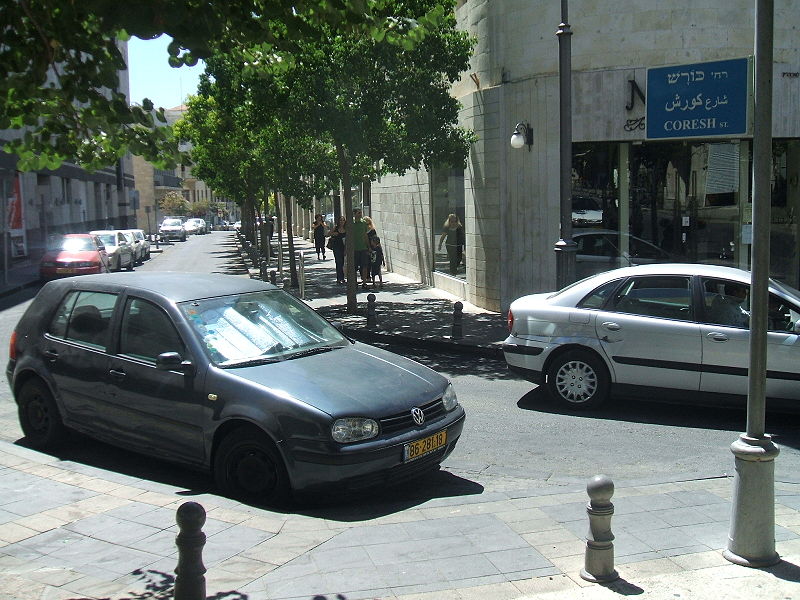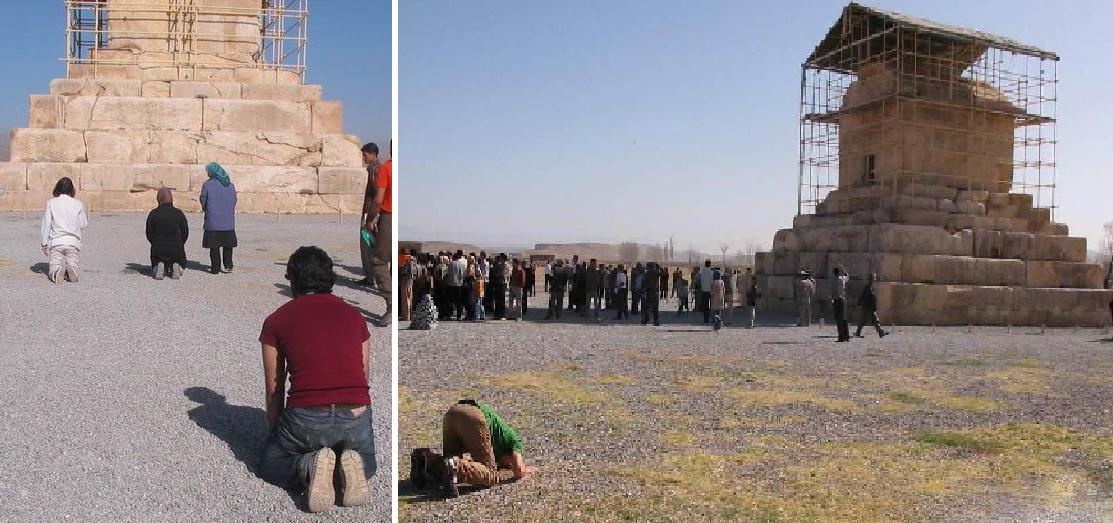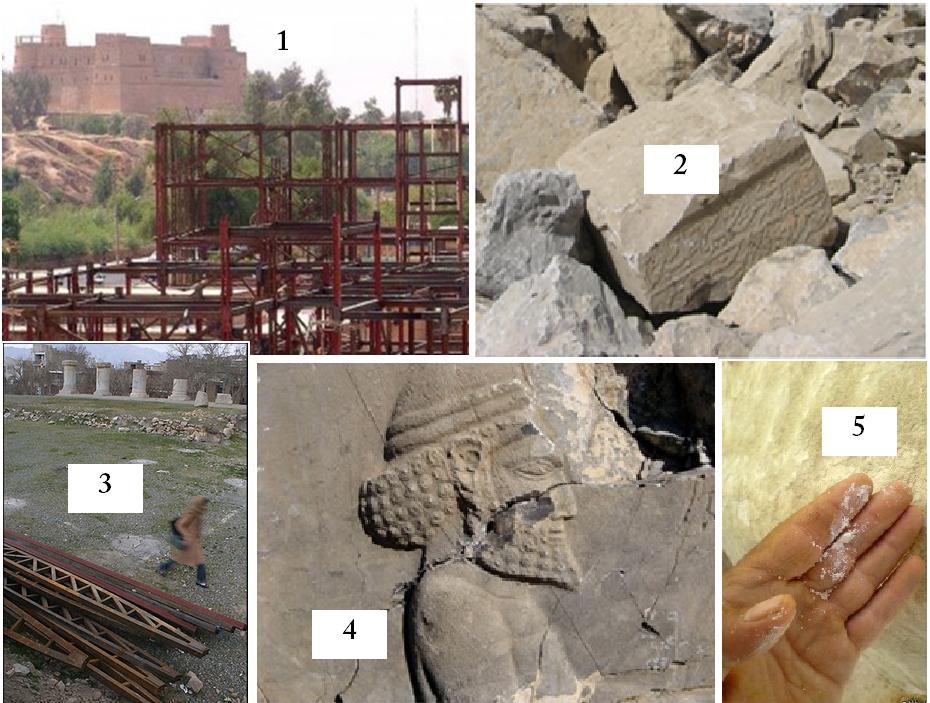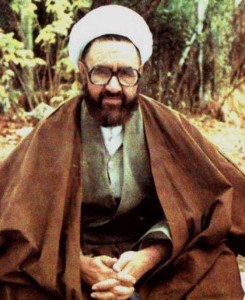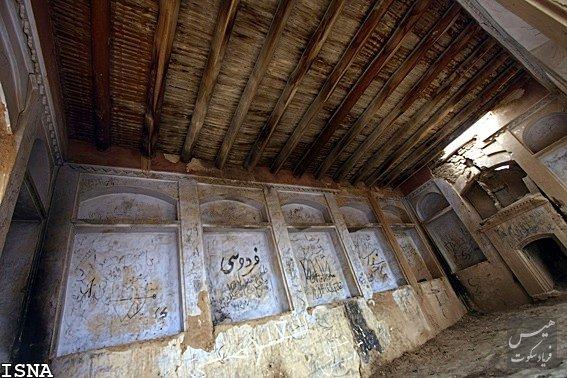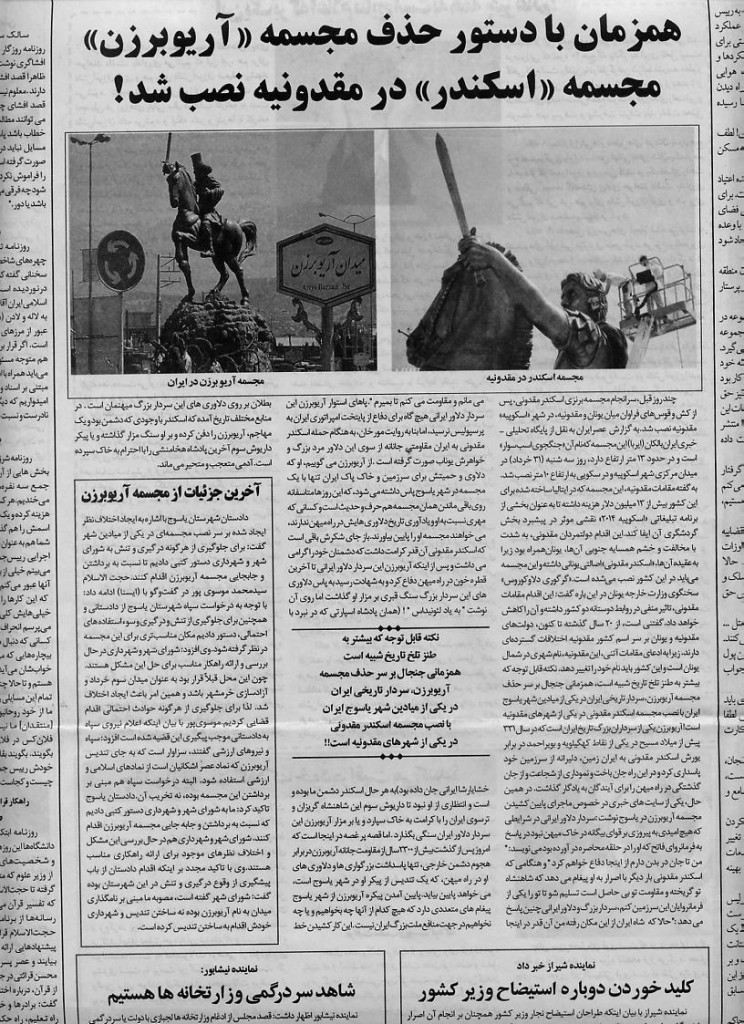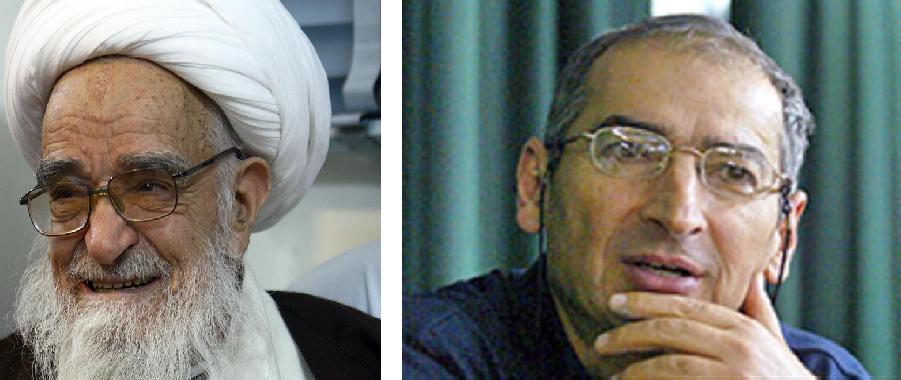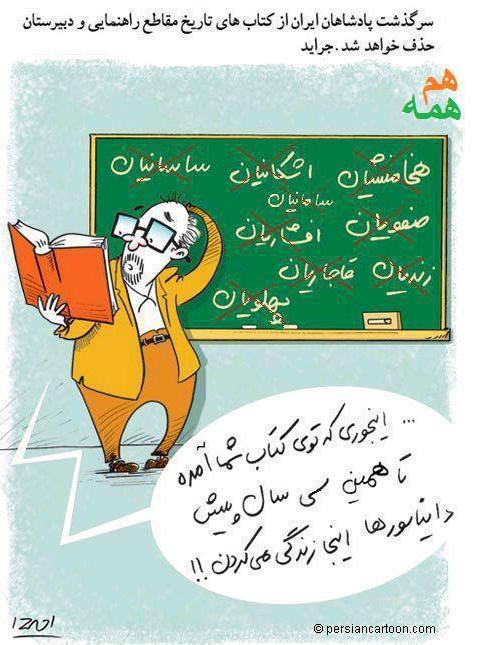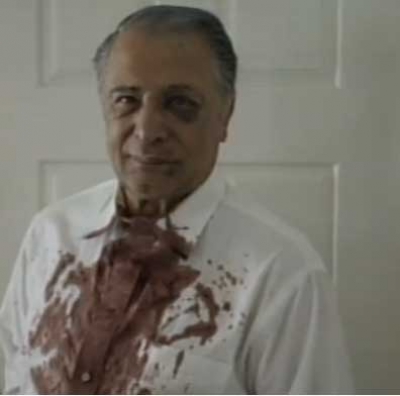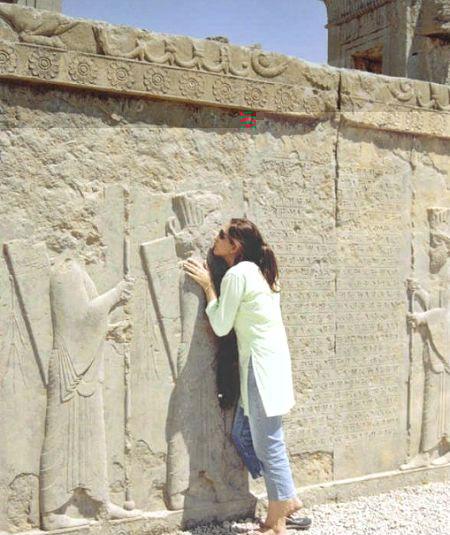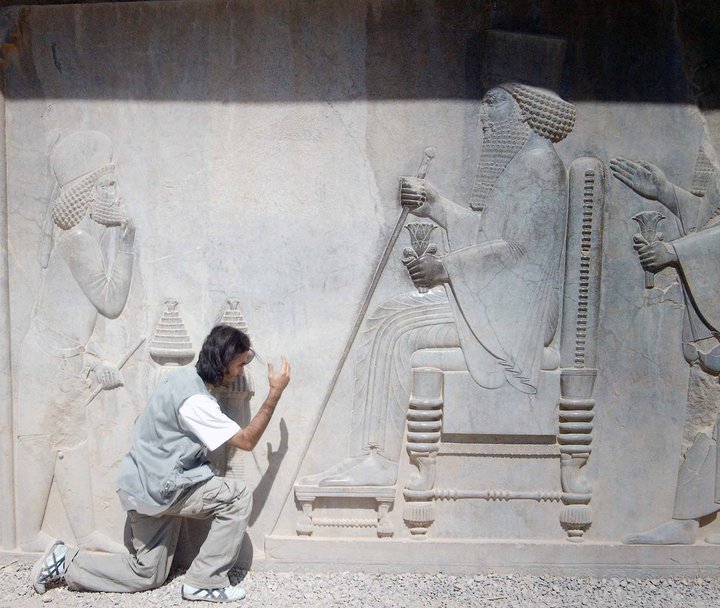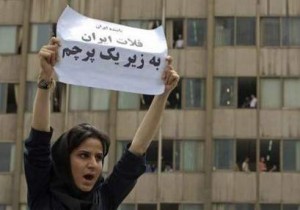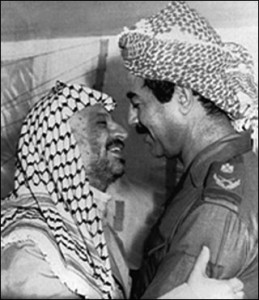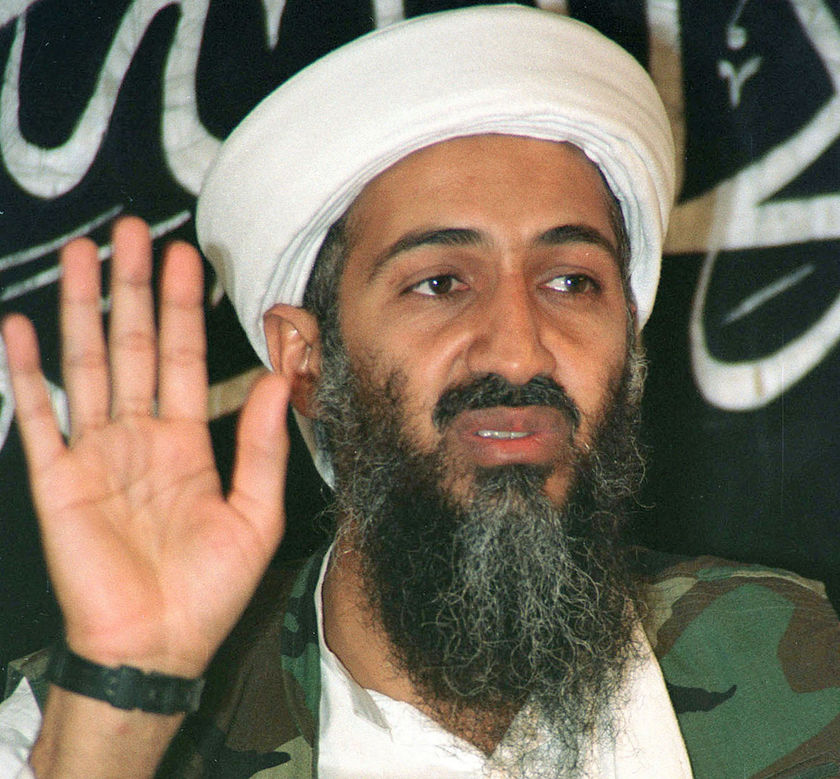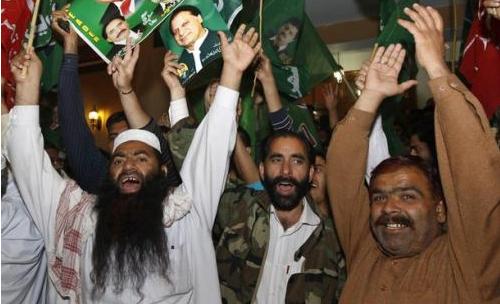Before undertaking this discussion it is vital to distinguish between the religion of Islam versus the Persophobic doctrines of the Muslim Brotherhood movements. The virulently Persophobic and religious extremism of the extreme religious right stand in stark contrast to the universalist doctrines of Islam. In fact, religion is not the focus of discussion here – the issue is the promotion of Persephobia which has little to do with Islam or religion.
Many of the members of Iran’s extreme religious right have their origins in the pan-Islamic Muslim Brotherhood movement (Ikhwan al-Muslemeen). These have a significant presence in Iran’s political apparatus. These have, since 1979, been leading an official policy of re-writing, distorting and even erasing the history of ancient Iran. These efforts have been supported by former members of the Iranian left/Communists who are highly represented in academic outlets within Iran as well as Western universities and think tanks.

Abbas Salimi Namin, the head of Tehran based Office for the Historical Research Studies for the Compiling of Contemporary Iranian History in 2006. Mr. Namin claims that Persepolis (the ceremonial capital of the Achaemenid Empire) was built by non-Iranian peoples and even called the monument as being of “Elamite” and “Russian heritage” (read more in the CAIS website…). Note that Namin wears a Palestinian scarf, symbolizing his identification with pan-Islamic causes and philosophy.
Ever since their arrival with the Iranian left into Iran in 1979, the Muslim Brotherhood has engaged in what can be termed as an ideological invasion and social re-engineering of Iranian society. Note the following report (in both Persian and English) by Sheda Vasseghi –شیدا واثقی-:
–آخوندها در گُذشتهنگاری ایرانِ باستان دستبُرده اند: این کار پلید را نادیده نگیرید– The Mullah’s rewrite of Iran’s ancient history: Don’t overlook this atrocity (Sept. 15, 2009)
Note the following excerpts from Vasseghi’s report:
“…any degree of bias observed in foreign sources about ancient Persians is nothing compared to the negativity, falsehood, and insufficient information provided by the current Iranian establishment to Iranian children… The overall tone is negativity towards Iranian monarchs, who define the nation’s culture and history, and all leaders of the Iranian communities, who helped build and protect the country. The ancient Persians are described as greedy, unjust, chaotic, and selfish… There is no mention of the ancient Iranian prophet, Zoroaster, who is credited with being the first monotheist… suggests that Cyrus’ motivation for conquest was to become wealthy. Nothing is mentioned of Cyrus’ famous bill of rights cylinder and his decree in freeing the Jewish captives from Babylonia while taking on the financial responsibility to rebuild their temple…”
The article below discusses the following topics:
- Muslim Brotherhood movement’s anti-Persian philosophy
- Muslim Brotherhood’s pan-Turk connections
- Eurocentrists and the Muslim Brotherhood: a mutual hatred of Cyrus the Great
- Muslim Brotherhood’s desire to eliminate ancient Iranian historical sites
- Persephobic Psychology: the late Ayatollah Motahari
- Persephobic Psychology: Ayatollah Nouri Hamedani
- Muslim Brotherhood: “Language of Hell is Persian and that of Heaven is Arabic“
- Muslim Brotherhood: Re-naming Persian Gulf as “Ar..b Gulf“
- Muslim Brotherhood: “Before Islam Iranians were an Illiterate, Uncivilized and Basically Barbaric People“
- Muslim Brotherhood’s Continued Hostility Against Iran’s Historical Legacy
- Iranian youth reject the Teachings of the Muslim Brotherhood
- Muslim Brotherhood: “Detach Iran’s Khuzistan province and give it to the Palestinians“
- Muslim Brotherhood in Arab Countries, Pakistan, India and Central Asia
Persophobia and the Muslim Brotherhood
Many laypersons, media outlets and academics believe that the Ikhwan al-Muslemeen (Muslim Brotherhood) and its modern offshoots (i.e. Taliban, etc.) is an anti-Western organization. This is only part of the truth.
A cursory examination of the movement’s origins in the 19th century reveals the organization as having strong anti-Iranian and anti-Indian traditions at its ideological core. Allen has perhaps summarized the thinking of the Ikhwan:
“…Out of the ruins of the Caliphate a brilliant, inclusive Islamic civilization flowered under the Mongols, centered on Persia, rooted in Sufism, and predominantly Shia. But Ibn Taymiyya and others who followed the Hanbali code of jurisprudence the last, strictest and least popular of the four main schools law in the Sunni tradition… this civilization was anathema and an offense to God” (Allen, 2006, p.44; Allen, C. (2006). God’s Terrorists: The Wahhabi Cult and the Hidden Roots of Modern Jihad. London, England: Abacus.).
More revealing is the role of British intelligence in not only helping to form the Muslim Brotherhood (today pan-Islamists, Wahhabists, pan-Arabists, etc.):
“The son of Shah Wallullah, Shah Abdel-Aziz, gathered around him a network of disciples who visited India in 1809. Radiating from Indian centers where the British Colonial Office ruled, Eastern mysticism engendered a revival of xenophobic, Islamic purity that considered all outside influences as suspect and evil. Some of the Islamic orders demanded that all Muslims safeguard themselves from the penetration of Persian traditions and Indian habits” (Dreyfuss & LeMarc, 1980, p.119; Dreyfuss, R. & LeMarc, T. (1980). Hostage. New York: New Benjamin Franklin House Publishing Company).
Imperial England was keen to seek and promote those “Muslims” who disliked the legacy of India and Iran in Islam. This coincided with British imperial objectives at the time. This was because this type of extremist ideology helped prevent India’s Muslims and Hindus from uniting against British rule in India. The promotion of anti-Iranism also assisted the undermining of Iran’s cultural legacy in India. The British were especially sensitive about the popularity of the Persian language in India, especially as this not only helped unite India’s Muslims, Hindus, Sikhs, etc. but also served as a cultural bond between the Indian subcontinent, Iran, Afghanistan and Central Asia. Islamic extremism served British imperial interests very well: in modern-day Pakistan for example, the legacy of the Persian language is shunned at the political, religious and even cultural levels. Much of this is due to the massive efforts of the Saudi Arabian establishment’s efforts in exporting Wahhabism. What is remarkable however, is that within Iran itself, pan-Muslim activists and their leftist ideological partners have also been hard at work in what can be termed as “Persephobia”.
By the early 20th century, the alliance between the British and the Muslim Brotherhood had become more open. In 1910 Ibn Saud told Shakespear of his desire to form an alliance with the British against the Ottomans (Allen, 2006, p.245). Ibn Saud stated to William Shakespear (British political agent in Arabia at the time) that:
“We Wahhabis hate the Turks only less than we hate the Persians for the infidel practices which they have imported into the true and pure faith revealed to us in the Koran” (Allen, 2006, p.245).
Above is a video by an Arabian Mullah who denies the existence of any Iranian civilization – the only relevant civilization is explained to be that of Islam. Pan-Muslims, with roots in the Muslim Brotherhood, have a profound dislike of Iranian civilization, especially in the pre-Islamic era and how this has influenced Islamic civilization. Powerful efforts have been underway to erase the history of Iran and her heritage. The greatest success of the Muslim Brotherhood has been in its ability to implant its followers into Iran since 1979.
Links between the Muslim Brotherhood movement (and its Wahhabist and Taliban offshoots) and British Intelligence have endured well into the early 21st century – see for example:
Pan-Islamists, much like their Arabist nationalist offshoot, pan-Arabism, as well as as the Wahhabian and Talibanist offshoots, all view Iranian civilization as offensive to Islam. The late Ayatollah Sadegh Khalkhali (1926-2003) who had a profound hatred of Cyrus the Great described him as a “… tyrant, a liar…” (Molavi, A., 2005, The Soul of Iran. Norton, p.14). Khalkhali maintained strong ties with Muslim Brotherhood movements in Arab countries as well as Pakistan.
Khalkhali also argued that all history pertaining to Cyrus the Great was all simply a concoction by the late Shah.

The late pan-Islamist activist Ayatollah Sadegh Khalkhali (1926-2003). Khalkhali hated ancient Iran and “called for the destruction of the Cyrus tomb and remains of the two-thousand-year-old Persian palace in Shiraz, Fars Province, the Persepolis” (see Molavi, 2005, p.14). Elaine Sciolino who interviewed Ayatollah Majdeddin Mahallati of Shiraz has confirmed that Khalkhali came to Persepolis with “a band of thugs” and after a thundering speech linking Cyrus to the late Shah, tried to destroy Persepolis – mercifully he and his rabble were stopped by local residents and non-political clergy (Sciolino, E., 2000, The Soul of Iran, Touchstone, p.168).
Pan-Turk connections and the Muslim Brotherhood
Khalkhali had spent time in Psychiatric wards before the 1978-1979 Iranian revolution. Parviz Rajabi defends Western Eurocentrists who express similar anti-Cyrus opinions as the late Khalkhali (For more on this topic consult: When Iranian Professors attack their own History: The case of Dr. Parviz Rajabi. By Kourosh Ahmadi & Shahyar Mahabadi).
But perhaps even more revealing is the fact that Khalkahli’s father was a member of the Soviet-engineered Azarbaijan Democratic Separatist and pan-Turkist movement which was a puppet of the Moscow’s Joseph Stalin. This revelation helps explain the late Khalkahli’s hatred of Iran and Cyrus the Great.
As an old English axiom states: like father – like son. Khalkhali’s father passed on his Communist and pan-Turkist inspired Persophobia to his son. This example adds further credence to the theory that members of the discredited pan-Turkist and pro-Moscow separatist movement of Azarbaijan had “re-invented” themselves as pan-Muslims. Now, Persophobia against Iran’s history, Persian language and cultural legacy could be officially promoted in the name of religion.
The links between pan-Turkist Persophobes and members of the extreme religious right continue to surface. One such figure is the fiery 1970 revolutionary activist, Ayatollah Hadi Ghaffari. The latter made news by virtually exploding onto the Iranian headlines in 1979 after he personally executed former Iranian Prime Minister Amir-Abbas Hoveida (1919-1979) during the early post-revolutionary days. He has since “transformed” into a reformist of the Green Movement – however, his real motives for joining the reformist movement is to promote pan-Turkist ethno-nationalism.

When the Leopard Changes its Stripes: From Pan-Muslim fanatic (1979) to Green movement reformist (2009) to modern-day pan-Turkist. Hadi Ghaffari in 1979 brandishing the UZI sub-machine gun he used to execute former Prime Minister Amir-Abbas Hoveida (1919-1979).
Once again there is a pattern: an extreme religious activist whose latent ideology is that of a secular ethno-nationalist. Ghaffari is yet another example of a pan-Turkist who has used pan-Islamist Persophobic ideology to promote ethno-nationalism or perhaps even a ethno-separatist agenda. Below is a pan-Turkist manifesto printed in Tabriz in July 2011 in which Ghaffari “comes out of the closet” by openly stating that he supports pan-Turkist separatism.
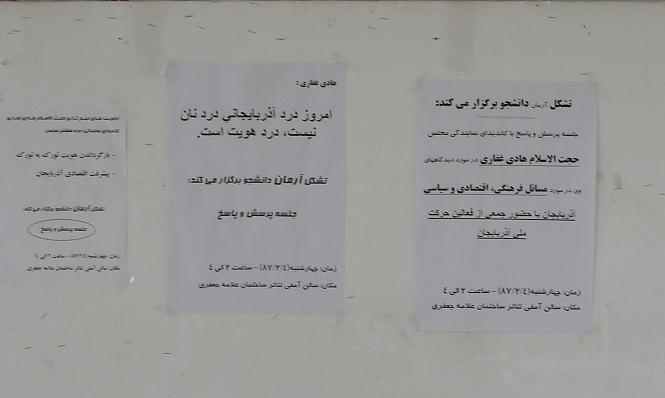
Hadi Ghaffari’s pan-Turkist manifesto. The middle page of the above pamphlet reads “Hadi Ghaffari: The pain of the Azarbaijani today is not one of bread but of identity“. This is almost an exact clone of the “manifestos” issued by the Moscow-invented and controlled separatist movement of the 1940s which was backed by Russo-Soviet tanks and troops occupying Iranian territory. Thanks to the neglect of history teaching Iran, many are not even aware of the history of foreign nations using pan-Turkism to promote their territorial and economic ambitions.
The Muslim Brotherhood and Eurocentrists: Shared hatred against ‘Cyrus the Great
Ironically, even as Iranian authorities work to officially degrade Cyrus the Great and his legacy, the legacy of Cyrus the Great is greatly appreciated by modern-day Jews, and celebrated even in Israel itself. Below is a photo of a street in Jerusalem named “Koresh” (Hebrew for Persian “Kourosh” or Cyrus):
Koresh or Cyrus street in Jerusalem. There is currently no street named Cyrus or Koroush in Tehran, the capital of Iran today. There is also an “Iran” street in Israel.
Efforts to re-write the history of Iran and its legacy are not confined to the aforementioned Khalkahli or the left/Communists. There are powerful efforts by the religious right to promote Persephobia within Iran. One of these was the late Dr. Parviz Rajabi:
When Iranian Professors attack their own History: The case of the late Dr. Parviz Rajabi. By Kourosh Ahmadi & Shahyar Mahabadi.
The late Dr. Rajabi had close ties with the anti-Semite Persophobe Mr. Nasser Pourpirar and the Iranian left. He was also a close supporter of Eurocentrist writer Mr. Jona Lendering (see further below).

The late Dr. Parviz Rajabi in Tehran who claimed that Iranians “lack logic”. He was accused of insulting Iran’s ancient Zoroastrian community. Dr. Rajabi also criticized Iranians in general for protesting against the racist movie 300 and Spiegel Magazine’s assault against Cyrus the Great.
The late Dr. Rajabi also made false assertions such as claiming that ancient Iranian sites such as Pasargadae are in no physical danger. Dr. Rajabi also attacked Iranian historians in the west seeking to defend ancient Iran’s heritage (read more…).
Despite over 3 decades of incessant propaganda against Cyrus the Great, the establishment has not achieved its aims. The current generation of laypersons and scholars (inside and outside of Iran) have shown a somewhat cool reception of the revisionist narratives of the extreme religious right and the Iranian left. The pictures below show cases of the extreme opposite effect among the Iranian youth towards Cyrus the Great at his tomb at Pasargadae (پاسارگاد: آرامگاه کوروش بزرگ):
The unintended results of official persephobia? Iranian youths bowing to the tomb of Cyrus the Great in summer 2011. While more research is required, it is reputed that these youths engage in this action as protest against the establishment’s anti-Cyrus and Persophobic policies. It would appear that despite over 3 decades of anti-Cyrus propaganda and the increasingly powerful influence of the Iranian left in western academia, anti-Cyrus propaganda has failed to sway the majority of the Iranian youth.
Another case of Persophobia is seen with Hossein Ravazadeh who made the following claims in June 2011 (see video below of his speech):
Hussein Ravazadeh claims in a speech in Tehran (June 2011) that ” History is written by Zionists…Iran never had a king named Cyrus the Great nor a king name Darius…they made Cyrus our king simply because he liberated some Jews…this has proven scientifically and recently verified from Germany …just because he Ravazadeh even claims that the Nowruz celebration was invented by the Jews! His statement “proven scientifically and recently verified from Germany” refers to Eurocentrist professors from Holland, Germany, England and France. The views of the latter against Cyrus the Great were published by Spiegel Magazine (July 15, 2008) and the Daily Telegraph (July 21, 2008) – see Kaveh Farrokh’s responses against these below: An article posted on Iranian.com describes the above three academics (left to right: Amelie Kuhrt from England, Wouter Henkelman from Holland, Zainab Bahrani from Iraq) as having “…completely discredited any positive reference to Cyrus [the Great], his legacy and any and all things Persian and Iranian…ridiculing all things Persian”. Click on the Iranian.com article for more information… Inexplicably, no other scholars of Iranian Studies in the West or in Iran raised any protests against these typically Persophobic articles. Instead, just days after he wrote the retorts in defense of Cyrus the Great to the Daily Telegraph and Spiegel in July 2008, Farrokh became the target of a highly vigorous and well-organized Holland-based ad hominem campaign by a select group of academics (mainly those with Assyriology-based training – see Iranian.com) as well as the internet (see responses to Jona Lendering in Bryn Maur and Rozaneh Magazine). Before launching his attacks on Farrokh Jona Lendering first sold his pictures to the Osprey company which was publishing Farrokh’s text – Shadows in the Desert. Osprey Publishing paid Lendering for his pictures and published these in Farrokh’s text on pages 23, 53, 54, 89, 116, 128, 179, 180, 181, 183, 189, 195, 225, 288. Then right after his payment by Osprey Publishing, Lendering attacked Osprey Publishing’s book by Farrokh – the main reason: Farrokh’s writings in favor of Cyrus the Great. It is worth noting that Jona Lendering has been furnished with an office in Tehran where his views against Cyrus the Great are supported by the religious right. Lendering’s website is not blocked in Iran and he is even allowed by Iranian authorities to organize tours to Iran (see for example, his 2015 tours here…). It is notable that a Human Rights Petition against Mr. lendering accusing him of racism is also blocked in Iran. It would appear that the current Iranian establishment is highly favorable to Eurocentrists as both groups share revisionist views of Iran’s history and legacy. The late Dr. Parviz Rajabi’s favorite man: Jona Lendering, one of many self-professed (and Eurocentrist-supported) experts on Iran, who is in fact a long-time archivist by profession. Lendering has been accused of racism (see Human Rights petition, Twitter. This is mainly due to Lendering’s insistence that the history of Cyrus the Great as a Human Right’s pioneer is simply “Shah propaganda”. Lendering’s controversial ideas were printed virtually verbatim off his Livius.org website in the Spiegel Magazine and Daily Telegraph newspaper in July 2008. Lendering is highly active against Cyrus the Great in Wikipedia (see article by Kourosh Ahmadi entitled: Vandalization of the Cyrus Cylinder article in Wikipedia by Eurocentirsts in pdf). Lendering also promotes smear campaigns against Iranian historians in the Wikipedia and internet. It is also worth noting that Farrokh had never written against Lendering or Livius.org. It is clear that the attacks on Farrokh were politically motivated – Farrokh was assaulted for defending Cyrus the Great as a Human Rights pioneer. Lendering and his Eurocentrist supporters in academia hold a number of controversial opinions about ancient Iran – note the following claims. Note the similarity of Lendering’s views (i.e. Cyrus the Great’ history being “propaganda”, etc.) to Ravazadeh, Ayatollah Khalkhali, Nasser Pourpirar, Parviz Rajabi and other members of Iran’s pan-Muslim activists, the Iranian left, etc. However, even more shocking is the fact that a few professors in Iranian Studies support Mr. Lendering’s views (see Iranian.com). The Jona Lendering case and Ravazadeh’s open support of Western Persophobes and Eurocentirsts against Cyrus the Great highlights the close cooperation between Persephones in Iran’s religious right and Western Persophobes (Eurocentrists) in media outlets, academia and Wikipedia. Note that in 2007, the London-based CAIS site (which provides resources for learning about ancient Iran) had also become the target of defamatory assaults by the Extreme religious right-Eurocentrist axis (see An Open Letter to Wikipedia Blog Founder, Jimmy Wales Regarding False Allegations Against CAIS). One of the Victims of Eurocentrists and the Extreme Religious right: Shapour Suren-Pahlav, host of the widely consulted CAIS website . Jona Lendering launched a very severe smear campaign against Mr. Pahlav and the CAIS website in the Wikipedia in 2007 (Read More…). Note that Mr. Pahlav had never written or acted against Mr. Lendering. Farrokh had also never written against Mr. Lendering before he too fell victim to Lendering’s attacks in 2008. Dangers to Iran’s Ancient Historical Sites Despite such aggressive (if not racist) behaviors, Mr. Lendering continues to insist that he advocates Iran and is not racist against Iranians. Lendering is also supported by Persophobic members of the current Iranian establishment including Dr. Parviz Rajabi in Tehran. Thanks in part to Lendering’s efforts and the Wikipedia, news of vandalism against Iranian sites are barred from reaching Western venues. The Extreme religious right and cultural destruction: (1) The ancient site of Susa mostly demolished for the building of Laleh Hotel (2) destroyed Safavid-era inscriptions at Pol-e-Khaju in Isfahan (3) the site of Kangavar being endangered by hotel construction (4) damaged profile of Persian trooper at Persepolis (5) deterioration of Pasargadae site as a result of engineering works. Jona Lendering who has an office in Tehran, has repeatedly called such reports (esp. Pasargard) as “hoaxes”. Interestingly such reports are also blocked by certain Eurocentrist administrators in Wikipedia, who label such reports as “Shah loyalist propaganda”. There are many examples of overt vandalism taking place against historical sites in Iran today – many of the establishment authorities as well as the Western media, are silent about these events. Another example is the Sassanian site of Bahram II which has become a shooting range for passers-by, tourists and locals. This has been happening since 1979 yet no action has been taken by government authorities, nor has any news of this been reported in the Western media. For more on this consult the following report by the Amordad publication in Persian which provides a full report on this topic: The Psychology of Persophobia: the case of the late Ayatollah Motahari Before we discuss Ayatollah Motahari, let us briefly return to the case of Ravazadeh. It is to not clear what Ravazadeh’s credentials are (i.e. whether he has written peer-edited history textbooks, peer-reviewed articles in major journals, etc.). Among Ravazadeh’s other interesting claims is that Pizza originated not from Italian Peninsula but in Arabia (see video below) … Hussein Ravazadeh claiming that Pizza originated in Arabia and that “the only difference today is that Sausages are mixed in as well”. There are many other examples of illogical behaviors as exhibited by the extreme religious right. The late Ayatollah Motaheri (1920-1979): Video of Ayatollah Motahari’s speech insulting ancient Iran and Iranians who respect ancient Iranian customs. The late Ayatollah Motahari had a profound dislike of ancient Iran and ancient Iranian customs. He also ridiculed Iranians who respect their ancient heritage. Note the parallels between the anti-Iranian beliefs of the late Ayatollah Motahari and the Persophobia of the Muslim Brotherhood/Taliban movement. Motahari was very specific in his open dislike of ancient Iran. His views were wholly consistent with the Muslim Brotherhood’s pan-Arabo/Islamic and anti-Iranian/anti-Indian/anti-Western/anti-Semitic philosophy. Below is an excerpt which expostulates Motahari’s Persophobic views against Iran’s ancient pre-Islamic heritage (note his visceral dislike of the poet Firdowsi who sought to revive the Persian language in the post-Islamic era): “Reviving ancient Persian words is to turn one’s back against the Koran. There was a committee and organization working with the Ministry of Culture which did its utmost to remove Arabic words and destroy Islam. At the Office of Farhangestan behind Sepahsalar school they consumed and took the wealth of the people. They changed the name of Ghabrestan [graveyard – Ghabr is Arabic in origin] to Goorestan [graveyard – Goor is Persian for grave], Ejtemaa [Arabic for gathering/meeting; also “society”] to Gerd-Hamayi [Persian for gathering/meeting], Jumaa [Arabic for Friday] to Adineh [Persian for Friday], vasa-el ertebat e Jami [Arabic origin term for vehicles/devices for mass communication] to Resanehaye Gorouhi [Persian origin term for vehicles/devices for mass communication]…all of this noise for Firdowsi, celebrating his millenium mark, building him a mausoleum and inviting foreigners from all countries to give them copies of the Shahname, acknowledging and promoting this empty-handed vicious man is for what? … Advertising for Firdowsi and the Shahname is advertising against Islam! Firdowsi and his Fairy-tale Shahname which is a book of poetry (meaning fantasies and poetic thoughts) tried to raise Falsehood against the Koran; confusion/doubt [موهومی] against certainty [یقین] …God gave him what he [Firdowsi] deserved in life and of his hereafter we do not know…He [Firdowsi] admitted “Thus I suffered in these thirty years – I quickened/bought to life the Ajam [non-Arab] with this Parsi – as they lost my treasure – there was no reward/compensation for my labors/efforts”. Source: Noor ol Mollok Koran/Ghor-an (Ayatollah Motahari), Fourth edition, Part six (see picture of book cover further below). Original Persian text below: ===================== زنده کردن لغات فارسی باستانی، برگشت از تعالیم قرآن است. انجمن و مؤسّسهای بود برای این امور که با وزارت معارف و فرهنگ رابطه داشت؛ و برای از بین بردن لغات عربی و فرهنگ اسلام نهایت سعی و کوشش را داشتند. و در ادارهی فرهنگستانی که پشت مدرسهی سپهسالار بود، برای این موضوع مال ملّت بیچاره را میخوردند و میبردند. نام قبرستان را گورستان، و اجتماع را گردهمایی، و جمعه را آدینه، و وسائل ارتباط جمعی را رسانههای گروهی، … این همه سر و صدا برای عظمت فردوسی، و جشنواره و هزاره و ساختن مقبره، و دعوت خارجیان از تمام کشورها برای احیاء شاهنامه، و تجلیل و تکریم از این مرد خاسر زیان بُردهی تهیدست برای چیست؟! …تبلیغات برای فردوسی و شاهنامه، تبلیغات علیه اسلام است. فردوسی با شاهنامهی افسانهای خود که کتاب شعر (یعنی تخیلات و پندارهای شاعرانه) است خواست باطلی را در مقابل قرآن عَلم کند؛ و موهومی را در برابر یقین برسر پا دارد. خداوند وی را به جزای خودش در دنیا رسانید و از عاقبتش در آخرت خبر نداریم. خودش میگوید: بسی رنج بردم در این سال سی / عجم زنده کردم بدین پارسی / چو از دست دادند گنج مرا / نبد حاصلی دسترنج مرا/ برگرفته از کتاب ِ نور ِ ملکوت ِ قرآن – تالیف آیت الله مُطهّری/ جلد چهارم / بخش ِ ششم ===================== The Noor ol Mollok Koran/Ghor-an [نور ِ ملکوت ِ قرآن] which provides a full view of the late Ayatollah Motahari’s anti-Iranian and Persophobic views. The hostility expressed by the late Motahari against the poet Firdowsi certainly helps explain why the Iranian authorities have allowed the epic poet’s historical home to fall into a state of ruin and decay as seen in the photo below: The decrepit state of the home of the epic poet Firdowsi at the village of Pazh (پاژ). Firdowsi’s works were instrumental in ensuring that Iran retained its distinct culture and history against the Caliphates. Many Iranians would argue that Firdowsi’s works ensured that Iran did not become an Arabian state under the Caliphates. This may explain why the religious right, notably the late Ayatollah Motahari, have often expressed hostility against Firdowsi and have allowed his historical heritage home to fall into ruin (Photo by Iran-based ISNA news agency). The Psychology of Persophobia: the case of Ayatollah Nouri Hamedani Members of the religious right (who for the main part tend to be clerics) regularly attack the history of ancient pre-Islamic Iran and often do so by distorting historical facts. The video below shows Ayatollah Nouri Hamedani (ايت الله نوري همداني) attacking the personage of Khosrow II. Ayatollah Nouri Hamedani (ايت الله نوري همداني) attacking the personage of Khosrow II. Interestingly the Ayatollah keeps referring to Khosrow II as a “Sultan” which is nonsense as the term is Arabian – the historical term used by the Sassanians would have been the Persian term “Shah” or “Shahanshah”. Another misleading aspect of the Ayatollah’s speech is that the prophet Mohammed “shredded” ancient Iran which is false- the Prophet Mohammed never attacked ancient Iran. In addition, if the Ayatollah is referring to the Arab invasion of 637-651 AD, Iran was not permanently “shredded” as she recovered with her culture and language intact – Iran today is not an Arabian country. It is also notable that Iran’s new generation of youth are no longer swayed by the Persophobia of the religious right. The above Ayatollah’s Persophobic views are also seen in an article penned by a non-cleric of the religious right : The article is reminiscent of today’s Eurocentric writers, pan-Arabists, and pan-Turkists and pro-Soviet Communists. Even more strange is the author’s attempt to falsely portray the late Dr. Manouchehr Eqbal (دکتر منوچهر اقبال) , as a Persophobe which is a completely false – Dr. Eqbal was actually the prime minister of Iran in 1957-1960. The Muslim Brotherhood: “Persian is the language of Hell with Arabic as the language of Heaven” Iranian TV has even produced a TV program which claims that the language of Hell is Persian and that of heaven being Arabic – see video below: Iranian state TV: -زبان رسمی بهشت عربی و جهنم فارسی-Persian is the language of Hell with the language of heaven being Arabic. Iran’s extreme religious right routinely equates the worship of god with Arabia and the appreciation of Iran and its heritage as “anti-Islamic”. It is noteworthy that the people promoting such Persephobia are not from Arab nations or Pakistan – the people on the Iranian TV programs are Iranian pan-Islamists. The youth of Iran, unlike the revolutionaries of 1979, overwhelmingly reject Persophobia – see the video below. Iranian song entitled: “Cyrus awaken, there is no more time for slumber -کوروش بیدار شو وقت خواب نیست – “. The Iranian youth have expressed their frustration agaonst Leftist/religious right inspired anti-Persianism with music and the arts. Note that this song also protests against the aforementioned TV program that argues that Persian is the language of Hell with Arabic being the language of Heaven. The Muslim Brotherhood: Calling Persian Gulf as “Ar…b Gulf” What is also of interest is how the religious right – in inspiration from their Muslim Brotherhood predecessors – also attack the name and legacy of the Persian Gulf. See video below of an Iranian government official on Iranian state TV explicitly referring to the Persian Gulf as A…b Gulf: –جعل نام خلیج فارس توسط رئیس پلیس امنیت اخلاقی ایران–News report from Iran in which an Iranian government official (Chief of Morality Police) refers to the Persian Gulf by pan-Arabist terminology. The Muslim Brotherhood: “Before Islam Iranians were an Illiterate, Uncivilized and Basically Barbaric People” Mr. Ali Larejani (who has served as the Chairman of the Iranian parliament), actually stated the following: in a speech he gave in Tehran’s prestigious Sharif University, May 2003: “Sadly, much lies are told today of Iranians before Islam, the extent of their culture and civilization, and the burning of their libraries during the Muslim invasion…Before Islam Iranians were an illiterate, uncivilized and basically barbaric people who desired to remain as such.” دکتر علی لاريجانی رئيس وقت سازمان صداوسيما در مورد شرايط ايران قبل از اسلام گفت: «متاسفانه امروزه دروغهای بسيار زيادی در مورد ايرانيان قبل از اسلام، ميزان فرهنگ و تمدن آنها و همچنين آتش سوزی کتابخانهها در زمان حمله مسلمانان گفته میشود» وی در ادامه افزود: «ايرانيان قبل از اسلام مردمانی بیسواد، بیفرهنگ و در کل وحشی بودند و در عين حال خود نيز علاقه داشتند که بیسواد باقی بمانند» وی همچنين تمامی پيشرفتهای فرهنگی و علمی ايرانيان قبل از اسلام را دروغ خواند و اندک فعاليتهايی نظير تاسيس دانشگاه «جندی شاپور» را حاصل تلاش عدهای از مسيحيان دانست.» (سخنراني در دانشگاه صنعتي شريف. خرداد ١٣٨٢) Ali Larejani has openly stated that “Before Islam Iranians were an illiterate, uncivilized and basically barbaric people who desired to remain as such“. The Muslim Brotherhood’s desire to Eliminate ancient Historical Sites The desire to literally wipe Iran’s history by the religious right was recently reported in the BBC Persian news outlet on June 23, 2011 [Commander of the Kuhkiloye Pasdaran demands the Destruction of the Ariobarzan statue]: Ariobarzan was one of the major Iranian resistance fighters against Alexander’s invasion of ancient Persia during the 330s to 320s BC. It would appear that Ariobarzan’s zealous defense of ancient Iran is not palatable to the religious right. Nevertheless to be fair, there are also some members of the clergy who oppose Persephobi and have spoken against such actions as reported in Mehr News –پاسداشت قهرمانان ملی مغایر ارزش های اسلامی نیست/ مخالفت با برداشتن تندیس-. Perhpas even more ironic is the fact just as the extreme religious right advocated the destruction of the Ariobarzan statue, the Republic of Macedonia (former Skopje of the former Yugoslavia) has laid claim to Greece’s Alexander and erected a statue in his honor – see Iranian newspaper report below: It is interesting to see one of former Yugoslavia’s provinces appropriating an ancient Greek historical symbol (Alexnader) just as the extreme religious right in Iran seeks to erase the Iranian resistance fighter, Ariobarzan, who fought against Alexander’s invasion of ancient Iran! Iranian Youth at Yasooj form a human chain around the statue of Ariobarzan in early July 2011 to prevent its destruction by the extreme religious right. The authorities have actually backed down with members of the Ministry of Information having declared that the statue wil not be destroyed (for more on this topic consult –درود بر غیرت مردم یاسوج!– ). This is yet another example of how the new generation of Iranian youth has rejected the Persophobic narratives of the extreme religious right and anti-Persian historical revisionism of the left. Muslim Brotherhood’s Continued Hostility Against Iran’s Historical Legacy There are numeours other documented cases of Persophobia among Iran’s extreme religious right -see for example the cases of Grand Ayatollah Safi Golpayegani as well as Sadegh Zibakalam. Left: Grand Ayatollah Safi Golpayegani [آیت الله صافی گلپایگانی] has composed anti-Persian Qasidas inside Iran. Right: Dr. Sadegh Zibakalam [صادق زيباکلام] has declared that “I would not give/exchange a single hair of an Arab…for hundreds of Cyrus’, Darius’, Xerxes’, Iran’s past [history]…and Persepolis!” Zibakalam who clearly hates Iran and Iranians has even delcared that “Iranians are mostly racist” – interestingly the Baku and Western supported GAMOH separatist organization published Zibakalam’s latest racist statements (click here…) These documented reports demonstrate that the conservative religious right has little regard for Iran’s cultural and historical heritage and has worked hard to write out Iran’s history from textbooks. Note the following reports below: Political cartoon (courtesy of Persiancartoon.com) depicting a teacher and blackboard which shows Iran’s pre and post-Islamic dynasties crossed out. Glancing over the Iranian history book, the teacher sarcastically states “it would appear that even the dinosaurs had lived in Iran up to thirty years ago”. As noted before such actions have no succeeded in “de-Iranizing” the Iranian youth. readers are referred to the following article in Persian: Thus far we have seen how the Muslim Brotherhood advocates the destruction of ancient sites, re-write history boosk in Iran and even ally with Eurocentrists to attack the legacy of Cyrus the Great. But there is more: Muslim Brotherhood advocates even resort to violence against historians who research ancient Persia. Note below the case of Dr. Basser Engheta -دکتر ناصر انقطاع– who was brutally attacked by pan-Muslim fanatics simply for having advocated the study and research of ancient Iran. Hate-Crime against Historians of Ancient Iran: On November 19, 2009 Dr. Nasser Engheta -دکتر ناصر انقطاع- was brutally attacked by two assailants right after he concluded an interview with a TV studio in Los Angeles. The assailants who were attempting to break Dr. Engheta’s teeth, struck him severely in his left eye, causing it ot bleed profusely. Read more about this horrific hate-crime against this Iranian historian in Pars Daily News. Iranian Youth rejects the Teachings of the Muslim Brotherhood A new breed of Persian Lioness (Shirzan e Iran): Young Iranian woman who was born after the 1978-1979 revolution embraces Achaemenid figures at Persepolis (see also Nowruz Celebrations at Pasargard in 2009). Iranian women have played a key role in preserving Iran’s ancient heritage against Persophobic ideologues among the religious right (i.e. Khalkhali, Motahari, etc.) , Tudeh/Leftists (i.e. “ex-Communist” Pourpirar, etc.) and various Iranian Persophobes (see the late Dr. Manoucher Eqbal discussed further below in item 3). For an insight into the rising dynamism of the Iranian youth see here: Despite over three decades of anti-Iranian propaganda at the educational, media and political levels, the majority of Iranians (notably the new post-revolution generations) have not been affected by Persephobia. This phenomenon is again indebted to the women of Iran who have historically preserved Iran’s culture and history across the generations. Iranian female cultural activist Gord-Afarid (گردافرید) revives the ancient history of Iran and the Shahname. Note that Gord-Afarid (گردافرید) is a legendary female warrior figure of ancient pre-Islamic Iran or Persia. For more on the crucial role played by the women of Iran in history see The Persian Lioness: Iranian Women in History. Also posted in Irandokht on-line magazine and news. For the translation of the article in Persian consult: شیرزنان ایرانی- زنان ایرانی در آینه تاریخ (pdf) An Iranian youth pays homage to the portrait of Darius the Great. The new Generation of Iranian youth overwhelmingly reject the decades-long anti-Iran and Persophobic narratives of the Extreme Religious Right and the Iranian Left/Communists. It is perhaps no exaggeration to state that three decades of incessant Persephobia within Iran has achieved the very oppostie of what was intended by the left and the religious right. There is now an ever-growing number of Iranian youth rejecting Persophobia. Iranian girl with sign that reads “People of Iran under one Flag”. Members of the extreme pan-Muslim religious right have been known to advocate detaching Khuzestan from Iran and handing it over to the Palestinains in the name of “Islam”. These views are supported by members of the Iranian left who are sympathetic to the detachment of various Iranian provinces such as Azarbaijan. Khuzestan, etc. The Muslim Brotherhood: “Detach Iran’s Khuzistan province and give it to the Palestinians“ Few are aware that members of the religious right advocated detaching Khuzestan from Iran in favor of a Arabo-Palestianian state. there was in fact great sympathy for the late Yasser Arafat who supported Saddam Hussein’s invasion of Iran – many Palestinians volunteered to fight for Saddam Hussein’s army against Iran in the 1980s. Unconfrimed reports suggest that these Palestinians “volunteers” committed severe human rights violations in occupied Iranian territory. Yasser Arafat flies to Tehran to meet the religious right and the Iranian left in the aftermath of the 1979 revolution. Ibrahim Yazdi (at left) holds hands with yasser Arafat (Arab headress next to Yazdi). Despite Arafat’s actions against Iran and the role of Palestinians in supporting Saddam Hussein’s invasion of Iran in 1980-1988, the establishment continues to advocate the Palestine issue. The constant pandering to Arabo-Palestinian and pan-Muslim ideologies have led to a strong backlash among Iran’s youth, who now openly reject Iran’s role in the Palestine and “Middle East” issues” as seen in the video below: Iranian youths chant “نه غزه نه لبنان جانم فدای ایران” [Neither Gaza nor Lebanon – my life sacrificed for Iran]. Note that many older people are also marching in support of the youths. Decades of pan-Muslim propaganda in tandem with Persephobia has led to a growing rejection of the Iran-bashing philosophies of the Iranian left and the religious right. Despite the social developments seen occurring among Iran’s population, the ideological trends of the (pan-Muslim) religious right (and Iranian left) have continued. Persephobia and Iran-bashing continues with strong evidence that these trends are also being promoted among Afghan refusgees residing inside Iran. This is best illustrated in an e-mail by Spitamenes forwarded to Kavehfarrokh.com by a writes and researchers (his e-mail deleted for privacy): ================== ———- Forwarded message ———- …there are strong Pan-Turkist sentiments within Afghanistan. There are not many Uzbeks or Turkmen who support Pan-Turkism, but Hazaras. In the past 30 years, many Hazaras have become attracted toward Pan-Turkism. This has a lot to do with the way Hazaras were treated in Afghanistan and in Iran (in Iran, all Afghan refugees are being treated very bad, much worse than in Pakistan or elsewhere). I have met a lot of very educated Hazaras who ackownlege their Persian language, but claim that they are proud of their “Turkic origin” and “Turkic race” and that they are “part of the large Turkic nation”. Many were brainwashed in Turkey, mostly because Afghan refugees in Turkey (and Hazaras in particular) have had a much better life than in Iran. And these Hazaras are doing some missionary work in their community, turning the population pro-Turkey and anti-Iran .=============================== It is interesting that Iran naturalizes Palestinians (of whom many are very anti-Shia), but refuses to naturalize Afghan refugees (of whom many are Shia) or give them access to schools and universities. Despite more than 2 million Afghan refugees in Iran (most of them are Tajik and Farsiwan), there are only 3000 in Iran’s universities. All of that pushes the people toward anti-Iranian movements and sentiments … and among these, Pan-Turkism is the most active. That is also a main reason why there is no “Pan-Iranian” sentiment among Afghans. Note the sentence stated in the above e-mail: Iran naturalizes Palestinians (of whom many are very anti-Shia), but refuses to naturalize Afghan refugees (of whom many are Shia) or give them access to schools and universities. Despite more than 2 million Afghan refugees in Iran (most of them are Tajik and Farsiwan), there are only 3000 in Iran’s universities. The religious right in Irna in fact goes much further than discrimination against Persian-speaking Afghanis – there are also documented cases where members of the religious right attempt to incite racism against Iran’s Afghani community – see video below: Iranian religious cleric inciting racial hatred against Iran’s Afghani community. Note how he fails to mention that Afghans and Iranians share the same heritage. language, literature and culture. In contrast, many members of the religious right advocate for pan-Arabo-Muslim causes, even as members of pan-Muslim movements in various Muslim countries and pan-Arabists are openly hostile to Iran and advocate its destruction. Note that despite Muslim Brotherhood activists, many Afghans not only appreciate thier close kinship with the Iranian family of peoples but even make common cause on a number of issues, such as the tragic death of Neda Agha-Soltan (1983-2009) who was killed during the 2009 protests in Tehran- see video below: –اجراي ترانه خياباني افغاني به مناسبت سالگرد ندا اقا سلطان توسط افغان هاي مقيم سوئد –Afghans in Sweden perform a song in honour of the slain Iranian girl, Neda Agha-Soltan (1983-2009) who was killed during the 2009 protests in Tehran. Pan-Muslim activists have worked hard to downplay the common cultural and historical links between Iranian peoples such as Kurds, Afghans, Persians, Lurs, Azaris, Ossetians, etc. It can also be added that many Palestinians joined Saddam Hussein’s invasion against Iran in 1980-1988, with reports of human rights abuses by Palestinian volunteers against Iranian civilians. Note the following excerpt and photo from the aforementioned article Pan-Arabism’s Legacy of Confrontation with Iran (Originally written in 2004, revised in October 24, 2010): Saddam Hussein (right) and Yasser Arafat (left). Arafat had obtained 2 billion dollars of funds from Iran just a year before Saddam’s army invaded Iran. Many Palestinians fought as volunteers against Iran during the 1980-1988 war, even as revolutionary activists in Tehran were advocating the Palestine issue throughout the 1980s. Spitamenes makes an excellent point: why does the Iranian establishment exhalt anti-Iranists and even looks the other way at their war crimes against Iranian civilians, yet officially discriminates against Afghans who are of Iranian stock, speak Persian and are of Persianate culture? The Muslim Brotherhood in Arab nations, Pakistan, India and Central Asia Iranian flag being burned by ordinary citizens in Syria in 2011. It is clear that Iran’s religious right has failed to win over the Arabo-Islamic world to its cause. Despite this failure, the religious right continues to promote pan-Islamic propaganda. Despite their 3-decade effort to stamp out Iranian culture and history, alongside their passionate zeal for pan Arabo-Islamic causes, the Mullahs have failed to win friends in the Arabo-Islamic world. See for example the following Reuters report: Saudi Arabia to US: Cut of the Head of the Snake (Iran) Given the cool reception by the populace across the Arabian and non-Arabian Islamic world, one may ask: Why do Iranian authorities produce movies extolling Arabian culture while ignoring movies that promote Iran (pre and post Islamic). The current Iranian establishment actually produces high-budget movies about Arabian figures such as Mukhtar Saghafi, etc. A vivid example of Persophobia was the late Mr. Osama Bin laden (1957-2011), a man who openly despised Iran and Persian culture. Before the Taliban were ejected from power by the US following the tragedy of 9/11, Bin laden practically ruled Afghanistan as his personal caliphate where he made vigorous efforts to stamp out Persian culture (i.e. Persian language, music, the Nowruz, etc.). The late Osama bin Laden (1957-2011). Before his ouster from Afghanistan, Bin Laden had turned the country into his own anti-Persian mini-Caliphate. Among his draconian Persophobic laws were bans on the use of the Persian language, musical instruments and the Nowruz (Iranian New Year). His mentors have gone so far as to insist that the Iranian word for Goodbye or “Khoda-Hafez” now be re-defined as “Allah-Hafez”. Bin Laden’s’ followers in Pakistan and India often use such terms. BinLaden’s attitude has been adopted by many of Bin Laden’s non-Arab followers in Pakistan and India where his supporters frequently shout “Death to Iran” during their regular anti-western rallies. Many in the western world misconceive the late Bin Laden as a religious fanatic; he was in fact a racist – his less than exemplary treatment of Persian speakers in Afghanistan certainly speaks for itself. Pakistani protestors in March 2009. Although not reported in the Iranian or Western media, Pan-Muslim and pro-Taliban activists in Pakistan often chant “Death to Iran” alongside the familiar “Death to America”, etc. Iran’s religious right tends to downplay such information and has continued to promote Persophobic policies within Iran’s cultural, political and educational arenas. The rise of anti-Iranism and Persophobia among Muslims not to mention Iran’s extreme religious right, has led Professor Emeritus Rochard Frye of Harvard University to declare: “Iranians now know better the value of their heritage…because of “Estilaye Dobareye Arab” “ See his interview on this subject (including the above quote 48 minutes into the interview) on the TV program below: Note also that Turkey has produced a beautiful tv-series about Sultan Salim of the Ottoman Empire and its defeat of Shah Ismail and Iran in the Battle of Chaldiran in 1514 – for full story in Persian, clck below link: توهین شبکه ترکیه به شاه اسماعیل و ایران را پاسخ دهیم) Recent Turkish movie about the battle of Chaldiran in 1514. Note the high quality of the picture, evident from its high budget. Interestingly, the Iranian establishment has produced no movies of Iranian expolits during the Safavid era against the Ottoman Empire, especially the determined resistance of Azarbaijanis against the Ottoman Turks or the brilliant victories of Shah Abbas, Nader Shah or Prince Abbas Mirza against Ottoman armies. The current Iranian establishmemt shows very little interest in Iran’s history and legacy (pre or post Islamic) while investing heavily in movies about Arabian culture.

–نقشبرجسته ساساني، هدف تيراندازي مردم–


فرمانده سپاه کهکیلویه خواستار تخریب مجسمه آریو برزن شد

یک تجربه نادر در خیابان ولی عصر -گزارش تصویری
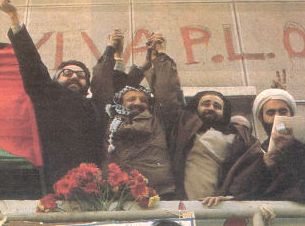
From: Spitamenes <xxxx>
Date: Mon, Apr 4, 2011 at 8:25 PM
Subject: Re: pan-turks in afghanistan
To: xxxx

